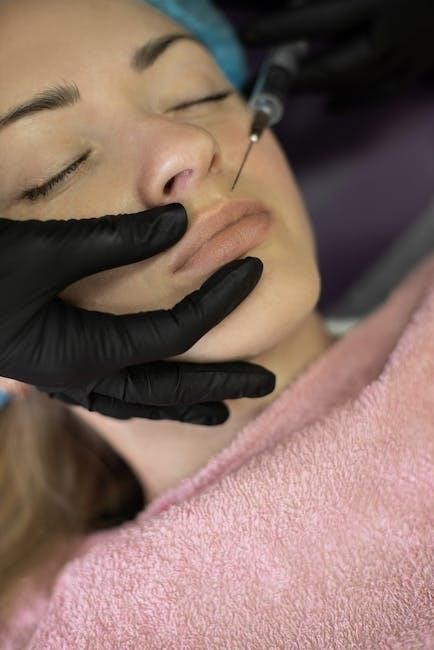Ultrasound needle guides are medical devices used to facilitate accurate needle placement during ultrasound-guided procedures, utilizing advanced technology to improve patient outcomes and reduce complications effectively always.
Definition and Purpose
Ultrasound needle guides are designed to aid in the precise placement of needles during medical procedures, with the primary purpose of improving the accuracy and safety of these interventions. The definition of an ultrasound needle guide encompasses a device that attaches to an ultrasound probe, allowing for real-time visualization of the needle and surrounding tissue. This technology enables healthcare professionals to navigate complex anatomy and target specific areas with increased confidence. The purpose of an ultrasound needle guide is to reduce the risk of complications, such as nerve damage or vascular injury, and to enhance the overall effectiveness of ultrasound-guided procedures. By providing a clear and stable platform for needle placement, these devices play a critical role in facilitating a wide range of medical interventions, from biopsies to regional anesthesia. Effective use of ultrasound needle guides requires a thorough understanding of their definition and purpose.

Types of Needle Guides
Various needle guides exist, including mechanical and electronic types, designed to facilitate accurate needle placement during ultrasound-guided procedures always effectively.
Mechanical Needle Guides
Mechanical needle guides are devices attached directly to the ultrasound probe, used for aligning the procedure needle so its trajectory remains under the ultrasound beam, allowing for improved precision and control. These guides are designed to match with specific types of ultrasound probes, ensuring compatibility and ease of use. The mechanical needle guide system provides a fine degree of control, enabling clinicians to accurately place the needle during various procedures, including regional anesthesia and biopsy. By utilizing mechanical needle guides, clinicians can reduce complications and improve patient outcomes, making these devices a valuable tool in medical settings. Overall, mechanical needle guides play a crucial role in facilitating accurate and safe needle placement, and their use is expected to continue growing in various medical specialties, including anesthesiology and radiology, where ultrasound guidance is commonly used. This technology has become essential in modern medicine.

Advanced Technology in Needle Guides
Advanced technology improves needle guide accuracy and precision, utilizing innovative materials and designs to enhance medical procedures effectively always with latest systems.
DeepSights NeedleVue Technology
DeepSights NeedleVue Technology is a unique attribute that generates high-resolution ultrasound imaging from the point-of-view of the needle tip, allowing for improved visualization and accuracy during procedures. This technology operates effectively even when contrast agents are present, offering enhanced imaging capabilities. The NeedleVue Technology is designed to provide clinicians with real-time feedback and guidance, enabling them to perform procedures with increased confidence and precision. By utilizing this technology, medical professionals can improve patient outcomes and reduce complications associated with needle-based procedures. The DeepSights NeedleVue Technology is a significant advancement in the field of ultrasound-guided interventions, and its applications continue to expand across various medical specialties. With its ability to generate high-resolution imaging, this technology is poised to revolutionize the way clinicians perform needle-based procedures, making them safer and more effective for patients. This technology is a valuable tool for medical professionals.

Applications of Ultrasound Needle Guides
Ultrasound needle guides are used in various medical procedures and specialties always effectively.
Regional Anesthesia Procedures
Regional anesthesia procedures benefit from the use of ultrasound needle guides, which provide accurate needle placement and visualization.
The use of ultrasound guidance has been shown to increase the success rate of regional anesthesia procedures.
Ultrasound needle guides are designed to match with specific types of ultrasound probes, allowing for a fine degree of control.
This control enables clinicians to perform procedures with increased accuracy, precision, and measurement resolution.
The current technology was designed to address the need for a needle guide involving very steep needle entry trajectories.
This technology allows for a fine degree of control for regional anesthesia procedures, increasing accuracy and precision.
The use of ultrasound needle guides in regional anesthesia procedures has improved patient outcomes and reduced complications.
In conclusion, ultrasound needle guides play a crucial role in regional anesthesia procedures, providing accurate needle placement and visualization.
Overall, the use of ultrasound needle guides has improved the effectiveness of regional anesthesia procedures.
The technology continues to evolve, providing better outcomes for patients undergoing regional anesthesia procedures.

Future Developments in Needle Guides
New technologies and innovations are emerging to improve ultrasound needle guides, enhancing their effectiveness always and accurately.
3D-Printing Technology
The use of 3D-printing technology in the creation of ultrasound needle guides has shown great promise, allowing for the production of customized guides that can be tailored to specific procedures and ultrasound probes. This technology enables the creation of complex geometries and designs that cannot be produced using traditional manufacturing methods. The use of 3D-printing technology also allows for rapid prototyping and testing, reducing the time and cost associated with developing new needle guides. Additionally, 3D-printed needle guides can be made from a variety of materials, including biocompatible plastics and metals, making them suitable for use in a range of medical applications. Overall, the use of 3D-printing technology has the potential to revolutionize the field of ultrasound needle guides, enabling the creation of customized, precise, and effective guides that can improve patient outcomes. This technology is still in its early stages, but it has already shown great potential.
Ultrasound needle guides improve medical procedures with increased accuracy and effectiveness always using advanced technology and designs.
Importance of Ultrasound Needle Guides
Ultrasound needle guides play a crucial role in medical procedures, enabling accurate needle placement and reducing complications. The use of these guides has been shown to improve patient outcomes, particularly in regional anesthesia procedures. By providing a clear and precise visualization of the needle, ultrasound needle guides allow clinicians to navigate complex anatomy with confidence. This technology has revolutionized the field of medicine, enabling healthcare professionals to perform procedures with greater accuracy and effectiveness. The importance of ultrasound needle guides cannot be overstated, as they have the potential to improve patient care and reduce the risk of adverse events. Overall, the use of ultrasound needle guides is a significant advancement in medical technology, and their importance will only continue to grow as the field of medicine evolves. They are essential tools for healthcare professionals, and their impact will be felt for years to come.